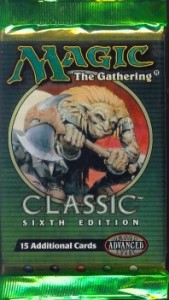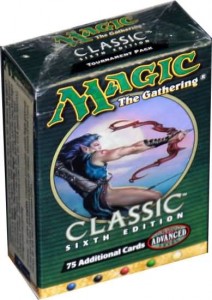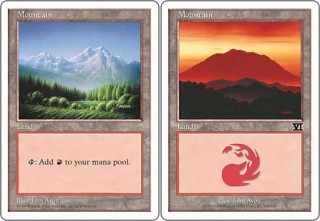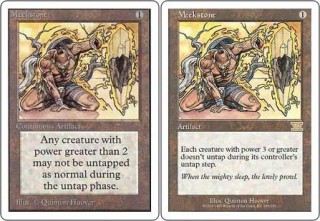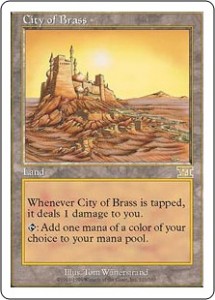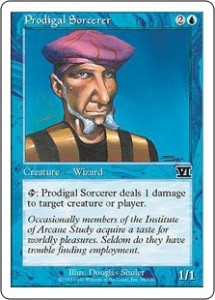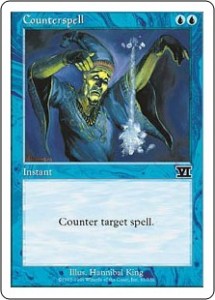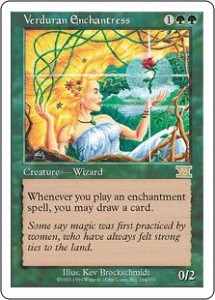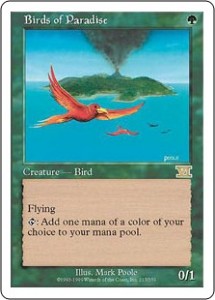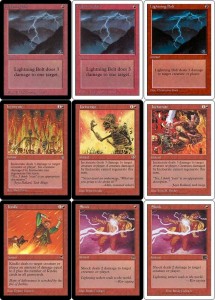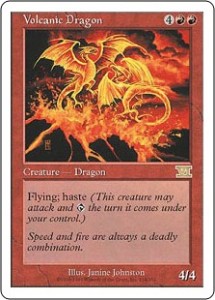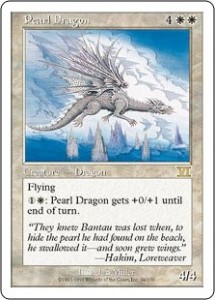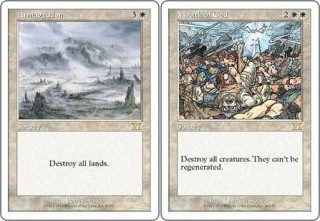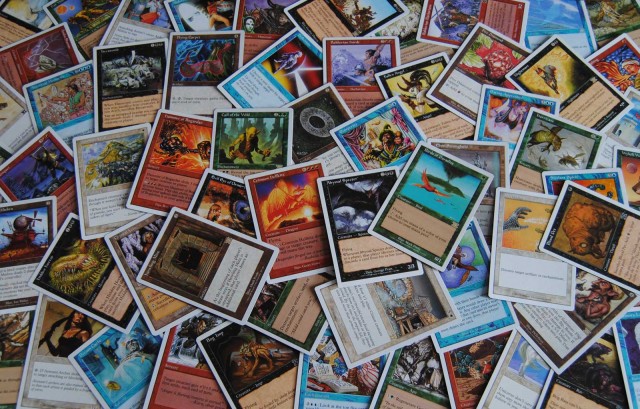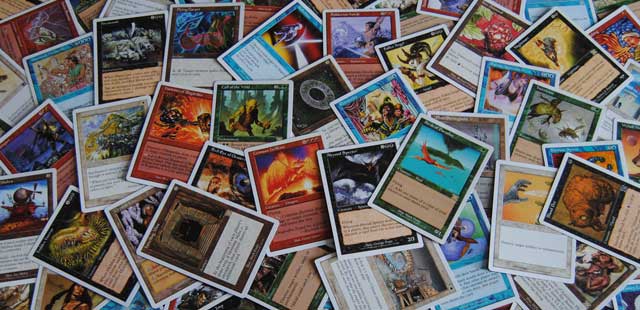
An Introduction to Classic Sixth Edition
Resembling more Chronicles and less core set, Classic Sixth Edition was more than just a collection of cards. It was a prophetic look into the future, setting precedence with its changes for the core sets to follow in its near future. The set itself wasn’t very “classic” when it was released on April 28, 1999.
The “classic” title still belonged to Fourth Edition, the last core representation of Alpha and Beta, but there was something that tied Classic Sixth Edition to the older sets – its size.
Classic Sixth Edition contained just 350 cards, the lowest total since Revised at 306 and Alpha Beta and Unlimited at 302. This was a sort of return to the classics, as Fourth Edition had ballooned to 378, while Fifth Edition took it a step further at 449.
In order to slim down from Fifth’s 449 to 350, 266 cards had to go to make room for 167 new cards. Those new cards added to the core set came from 12 different sets; 12 cards were from Alliances, one from Exodus, five from Fourth Edition, four from Homelands, three from Ice Age, one from Legends, 56 from Mirage, two from Portal, four from Stronghold, 22 from Tempest, 30 from Visions, and 27 from Weatherlight. When mixed with the 183 cards that were reprinted from Fifth Edition, it made Classic Sixth resemble more Chronicles than core set.
Of note, Classic Sixth was the first core set to have an expansion symbol (at least in English language) and by default that expansion symbol was color-coded by rarity. It was also the first reprinting of Alliances, Mirage, Visions, and Weatherlight cards.
Changes in rarity were now common from core set to core set and Classic Sixth was no different as 20 cards changed rarity in some fashion. Most notably was Fallen Angel’s move from uncommon to rare and Pestilence and Power Sink both making the jump from common to uncommon. Summer Bloom, Prosperity, and Hidden Horror all fell from rare to uncommon.
Interestingly, no cards with Trample were printed in the set and Cycling and Echo didn’t make it in because they were introduced in the still incomplete Urza’s Block.
The big changes wrought by Classic Sixth Edition were in relation to the changes of the game itself, some cosmetic, others more important, but all were arguably responsible for dumbing down the game, or at least that was the thought at the time.
Two relatively cosmetic changes were in regards to Lands and language. Basic Lands were changed from having rules text such as “TAP: Add Mana to your mana pool.” to just being a Mana symbol, similar to what was printed on Basic Lands in the beginner’s set of Portal and Portal Second Age. The language change was a sign of things to come, although it was just the replacement of rules text “unaffected by summoning sickness” with the keyword ability of “haste.” Eventually, other rules text would be changed to an ability keyword, but for now it was just haste.
There were plenty of actual non-cosmetic rule changes that occurred when Classic Sixth Edition came into being. The “stack” was introduced replacing the old “batch system,” which in turn also made Interrupts obsolete. From here on out, nothing would be faster than an Instant and all Interrupts were given errata stating they were now Instants. Mana sources were also obsoleted, but this wasn’t as big a shift as losing Interrupts.
See a complete list of the Additions and Subtractions from Fifth to Sixth Editions.
Another change was that a player at 0 life died instantly, instead of at the end of the phase, which was detrimental to a few combos, most notably the Channel/Drain Life Combo for infinite damage because you couldn’t wait until Drain Life finished to gain back the life that was used to pay for the Channel.
Although Continuous Artifacts were taken out of the game once Revised was printed, some of those cards still operated under the assumption that tapping them would negate their effect. This was no longer the case as the rule was that most tapped artifacts no longer had their abilities turned off, making it a feature of the card and not the card type. While this was horrible for Winter Orb, it didn’t make the cut from Fifth to Sixth Edition, so it wasn’t around in Type II tournament play to be affected, but it still made waves in Type I.
The other change was also fairly cosmetic, but it had a prophetic impact on what the game would become. Creature cards no longer had “Summon.” It was instead replaced with “Creature – .” Following the “Creature -” was one or two creature types, and in the future it would more commonly be at least two types. This was a hint that tribal sets such as Fallen Empires, would be coming soon.
All of these changes caused a small exodus – small, of course, in comparison to the one that took place following the “emergency banning” of the Urza’s Legacy‘s Memory Jar. Classic Sixth Edition was proof that Magic: The Gathering was in fact changing, but in hindsight, it could not have remained as it was forever.
Now, on to the cards themselves – those that made the cut and the lament of those that didn’t.
The Lands of Classic Sixth Edition: Sac Lands and Pain Lands
There were 17 Lands in Classic Sixth Edition, the five basic Lands, Fallen Empire‘s “Sac Lands,” Ice Age’s “Pain Lands,” as well as, Crystal Vein and City of Brass. The only lands not to make the cut from Fifth Edition were the Storage Lands from Fallen Empires and “Urzatron” which was Urza’s Mine, Urza’s Power Plant and Urza’s Tower.
The storage lands in not being reprinted just joined the Mana Batteries in the out-of-print bins, because they were great during Magic’s origins, when the game was slower, but they were both two slow for use in many decks, both tournament and casual.
Fallen Empires’ Sac Lands, were still sparingly used so their return was welcome, but the continuation of the Ice Age Pain Lands was celebrated. Second to the actual Dual Lands, last seen in Revised, the Pain Lands were the closest thing and were widely used, because of this.
Crystal Vein was essentially a colorless version of the Fallen Empire’s sac lands, so it makes sense that it was reprinted, while City of Brass was as celebrated as the Pain Lands. Sure, with all of the other options available, like the lands of Alliance‘s, for example, there were other lands that could have been included, but player’s were not unhappy with the lands included in sixth edition.
The Color Black in Classic Sixth Edition: Great Additions Didn’t Detract from the Missing Dark Ritual
The reaction to Black in Classic Sixth Edition was colored by one card that didn’t make the cut; Dark Ritual. Although, the saving grace of its absence from Sixth was its inclusion in Urza’s Saga. Because of this it was still tournament legal in all formats, but it was still a scare.
Could there really come a time when Dark Ritual would be out of print? Sadly, as we now know, the answer is yes and this was a sign for some older players to move on.
Dark Ritual wasn’t the only staple missing from Sixth; Animate Dead, Black Knight, Bad Moon, Drain Life, Lord of the Pit, Paralyze, Pit Scorpion, Sorceress Queen, Unholy Strength and Vampire Bats also missed out on the cut. Even the relatively “new classic” Necropotence, was also shown the end of it’s rope.
Some of these cards may have run their course in Magic’s history, although only Lord of the Pit seems to fit the bill, in my opinion. Of the rest, Unholy Strength, Paralyze, Black Knight and Animate Dead, these were staple cards that were expected to be in print forever.
But all lamenting aside, the additions of Vampiric Tutor, Stupor, hidden horror, hecatomb, Doomsday, the return of Legend’s Syphon Soul and Fourth Edition‘s Greed combined with the mainstays of Pestilence, Nightmare, and the new classic Specter in Abyssal Specter made some of this upheaval tolerable.
In spite of what it lost, Black still remained a power color, continuing to run its core concepts of discard, reanimation and power with speed.
Abyssal Specter, Coercion, Mind Warp and Stupor held the reigns for discard, while Ashen Powder, Gravedigger, hidden horror and Raise Dead remained steadfast for reanimator decks.
Vampiric Tutor, Blood Pet, Doomsday, Fallen Angel, Greed, hecatomb and Syphon Soul remained stalwarts for classic Black decks, looking to adjust with the times.
The Color Blue in Classic Sixth Edition: Old Classics and New Classics
Blue may have lost some control with the unprinted cards in Classic Sixth Edition, but only by quantity and not from a qualitative standpoint.
Of course there was the loss of Drain Power, which was mourned, but Flood, for example, wasn’t a huge loss. The mourning of Flood’s loss was because of Blue’s now expanded stable of creatures with flying. Pirate Ship, a big Tim, wasn’t nearly as missed because of the influx of other Tims, like Tempest‘s Rootwater hunter, Urza’s Legacy‘s Thornwind Faeries and the reprinting of the original Tim Prodigal Sorcerer.
The loss of Sleight of Mind was marginal at best as the game had passed this kind of deck by at the time of Sixth Edition. Time Elemental’s loss was softened by the fact that Stasis was also no longer in print, which moved the Stasis deck t Type I tournament play, which was welcome to any player of Type II that didn’t play a Stasis deck.
In Fifth Edition, Control Magic was replaced by Binding Grasp and then in Sixth Binding Grasp was replaced by Abduction so all things were basically equal, although Seasinger, the creature version of Control Magic, printed in Fifth, originally from Fallen Empires, was also lost in the shuffle.
Counters retained their potency with the inclusion of Counterspell, Spell Blast, Power Sink and Deflection, plus the addition of Visions‘ Desertion, as only Force Spike was gone.
One of the bigger losses was that of Unstable Mutation. This card, sometimes referred to as the “shrinking Giant Growth,” was not only Blue’s best creature buff, but it was versatile enough to be cast on an opposing creature to eventually remove them from the game by killing them with the -1/-1 counters.
Still, there were some absolute positives. The reprinting of Lord of Atlantis was a huge boon for Merfolk decks, because of the ever expanding Merfolk tribe. For some “old school” control Mana Short was still available, as well.
The library manipulation of Alliances‘ was returned to blue with Browse, Diminishing Returns, and Library of Lat-Nam, with that added bonus of card draw from Visions’ Inspiration and Prosperity. Rounding out the great additions was Mirage‘s Mystical Tutor, which players of Blue were happy to see return to the realm of Type II tournament play.
The Color Green in Classic Sixth Edition: Poison’s Big Loss while the Birds Fly High
Ever since Tempest‘s release, straight Green deck’s were skewing tribal, specifically tribal elves and with Sixth Edition, that skewing was much more forced.
Instill Energy, Venom, Aspect of Wolf and Rabid Wombat were all principal players in the Wombat Enchantress deck’s of that time. Although the Verduran Enchantress remained in Sixth Edition, the loss of the Wombat and some of the principle enchantments of the deck, made the Wombat Enchantress deck a thing of the past, left to only be playable in the Type I competitive format.
Loveable commons that many players started out learning Magic with, such as Craw Wurm, Durkwood Boars and Scrybe Sprites were all no more. With the removal of such classic commons, this was a sign of the changing face of Magic.
Gone too was Marsh Viper, the staple of Poison Counter decks everywhere, because it gave a player two poison counters and not just one. Two of Green’s favorite sons also met their fate; the 8/8 behemoth of Force of Nature and the pumpable and loveable Killer Bees were both left off the Sixth Edition Roster.
But the biggest loss Green sustained was that of its main library manipulation card Sylvan Library. As versatile as Sylvan Library was, it was commonly being used in combination with a card that did make the Sixth Edition cut, Call of the Wild.
Surprisingly, Thicket Basilisk remained, although it flying partner in crime, Cockatrice, did not remain along side it, in print. Although, this spawned many a debate as to why one was printed and the other was not, in addition to the fact that many players would have traded the Basilisk for the Cockatrice in a heartbeat.
As with the other colors, Green had it’s tutor, Worldly Tutor reprinted in Sixth Edition, as were some of its Mirage counterparts, Waiting in the Weeds, Tranquil Grove and Maro. Two classic cards that thankfully remained in print in Sixth Edition were Llanowar Elves and Birds of Paradise.
Like other cards that had been replaced by a functional reprint, Llanowar Elves could have been replaced by Fyndhorn Elves, but it wasn’t and it also still retained its original artwork, which was a relief to some and a wonder to others. But nothing was bigger in Green, than the collective sigh of relief for the continued printing of Birds of Paradise. Birds of Paradise was beyond beloved, it would have created a huge outcry had it missed the cut. Thankfully, it remained in print, also with its original artwork.
The Color Red in Classic Sixth Edition: Shock replaces Incinerate and other Changes
You cannot talk about Classic Sixth Edition Red without talking about the progression from Lightning Bolt to Incinerate to Shock.
From the beginning of Magic through Fourth Edition Lightning Bolt was the staple direct damage card. Then Incinerate, having been printed in both Ice Age and Mirage, replaced Lightning Bolt in Fifth Edition. Incinerate was temporarily usurped during Tempest by Kindle, until Shock was released in Stronghold. Finally, in Sixth Edition, replacing Incinerate, which had replaced Lightning Bolt, was Shock.
From one Red Mana for three damage, to one colorless and one Red Mana for three damage, to one colorless and one Red Mana for two (and up to nine damage), to one Red Mana for two damage, this was a progression that not just players of Red, but all players followed. At the time of Classic Sixth Edition’s printing, it was a lamented progression and a sign of change in the game, because Lightning Bolt was seen as not just a staple Red card, but a staple Magic card.
Two other staple Red direct damage cards fell by the wayside on the journey from Fifth to Sixth Editions; Disintegrate and Fireball. Although, Mirage’s Volcanic Geyser was added and it was an Instant instead of a Sorcery, it didn’t have the multiple target capabilities of Fireball. Also from Mirage, hammer of Bogardan was added to Sixth Edition, as well.
Red also lost Ball Lightning, Blood Lust, Mana Clash, Mana Flare and, the first dragon, Shivan Dragon. The only one of these to be, essentially, replaced was Shivan Dragon, such a staple that it was replaced by Volcanic Dragon and Crimson hellkite.
There were some celebrated additions; Relentless Assault, Final Fortune, Balduvian horde, AEther Flash and Fervor. The Goblin tribe retained Goblin King and Goblin Warrens with the additions of Raging Goblin and Goblin Recruiter. Land destruction decks were happy to see Alliances’ Pillage join Stone Rain and Conquer, but still had to fill the hole left from Orcish Squatters.
All things considered, Red made more of a lateral move with the changes from Fifth to Sixth Editions, but Magic was changing and all of the colors had to make adjustments.
The Color White in Classic Sixth Edition: Retaining Control where it Matters Most… Mass Destruction
Upon first glance, White was the least affected color in the progression of Magic from Fifth to Sixth Editions. However, that doesn’t mean there weren’t any casualties of that progression.
White staples like White Knight and holy Strength ended their tenure in print. In fact, White’s anti-Black cards were limited beyond White Knight as Karma and Angry Mob were also casualties from Fifth to Sixth. Even Ice Age stalwarts Blinking Spirit and Caribou Range missed the cut. As did Personal Incarnation and Circle of Protection: Artifacts.
But the single card, not printed in Sixth with the biggest loss was Island Sanctuary. The Sanctuary’s big claim to fame was in combination with Homelands‘ Mystic Decree or going further back Legends’ Moat. But any deck with these combinations was no longer going to be able to compete in Type II. This relegated those decks to Type I or Type 1.5 as it was called at the time.
But more noteworthy was what White received in addition to what it retained in Sixth Edition. Although Serra Angel was still missed in the air for White, Visions‘ Archangel and Mirage‘s Pearl Dragon filled that void in the air.
Other staples that remained were Disenchant, Spirit Link, Animate Wall and Crusade, which was happily joined by Celestial Dawn. Icatian Town was a useful Sorcery that was joined by other useful spells such as Reverse Damage and Reprisal. Enlightened Tutor, still restricted in some formats was also reprinted.
White control didn’t disappear either, as Kismet and Pacifism were in full force. As were the classic mass destruction spells Wrath of God and Armageddon. Now Wrath of God was mainly used as a safety, last resort kind of spell, but Armageddon had plenty of decks based around it, and those decks didn’t go anywhere.
Although some had to be tweaked, the Squatageddon deck for example didn’t have Orcish Squatters anymore in Type II, but those decks were changed up easily enough. So long as White retained Wrath of God and Armageddon, there would always be fear in an opponent once four White Mana were available.
The Artifacts of Classic Sixth Edition:
The Artifacts of Magic also saw some turnover from Fifth to Sixth Editions. Classic artifacts that found their way into countless decks, Fellwar Stone, Nevinyrral’s Disk, Mana Vault and Library of Leng were no longer available. Poison Counter decks, not only lost Marsh Viper, but they lost Serpent Generator as well, an artifact that made 1/1 Snake tokens that could give poison counters.
However, the big loss was Winter Orb, although it wasn’t that big of a loss because of the new rule changes that accompanied Classic Sixth Edition. Since the new rule of “most tapped artifacts no longer had their abilities turned off,” the Winter Orb / Icy Manipulator combo wasn’t what it used to be. This still affected many Type I decks, but it was the death knell for those decks in Type II.
What remained however was the Lucky Charms and the addition of the Diamonds. The Lucky Charms; Ivory Cup, Crystal Rod, Throne of Bone, Iron Star and Wooden Sphere, were still holdouts from Magic’s origins, while the addition of Mirage‘s Diamonds; Charcoal, Fire, Marble, Moss and Sky, were welcome to replace the now out-of-print Fellwar Stone.
Among the notable additions from Visions were Snake Basket, a kind of replacement for Serpent Generator, the ever useful for confusing games Teferi’s Puzzle Box and Wand of Denial, while Mirage added Phyrexian Vault and Grinning Totem in addition to the Diamonds.
Four remaining notables that survived from Fourth to Fifth to Sixth editions were howling Mine, Meekstone, Millstone and Ornithopter. While howling Mine and Meekstone could be used in many decks, the Millstone was still a complete deck concept and Ornithopter was a mainstay for the Fruity and Cocoa Pebbles decks that remained in existence.
In Conclusion Classic Sixth Edition
What can be said about Classic Sixth Edition? It was smaller, which in theory may have been an attempt at competitive balance, but all it really did was limit the amount of viable Type II decks, in tournament play.
It changed the game in very real and basic ways, which made it simpler. Although I cannot refute that simpler can easily equal a dumbing down of the game. Classic Sixth Edition was necessary, although this is a statement that can only be made now with the hindsight of knowing what came after it.
But on a whole Classic Sixth Edition, from the context only of the cards it contained and those it didn’t, was a fairly balanced, well thought out, set. This was however, not a concept held during its release, because the cards within the set were well overshadowed by the changing of core rules and in turn by a changing of the game itself.
